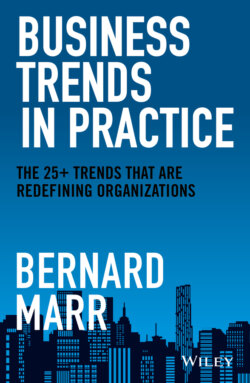Читать книгу Business Trends in Practice - Бернард Марр, Bernard Marr - Страница 28
Trend 7: 3D Printing
Оглавление3D printing allows us to rethink how we produce things. It gives manufacturers the ability to make things that simply can't be produced with traditional methods, to streamline the manufacturing process, and easily create highly personalized products (even completely unique one-offs), all while eliminating waste and reducing costs.
Also known as additive manufacturing, 3D printing means creating a 3D object from a digital file, by building it layer upon layer. Traditional manufacturing tends to be a subtractive process, meaning an object is typically cut or hollowed out of its source material, using something like a cutting tool, which is hardly the most efficient way of manufacturing things. 3D printing, on the other hand, is an additive process, meaning you create the object by adding layers upon layers of material, building up until you have the finished object. (If you were to slice a 3D printed object open, you'd be able to see each of the thin layers, a bit like rings in a tree trunk.) So, with 3D printing, you start from nothing and build the object up bit by bit, as opposed to starting with a block of material and cutting or shaping it down into something.
The main benefit of 3D printing is that even complex shapes can be created much more easily, and using less material than traditional manufacturing methods (good for the environment and the bottom line). Transport needs are reduced, since parts and products can be printed onsite; a factory, for example, could 3D print replacement machinery parts rather than having to order and wait for components to be shipped halfway around the world. And one-off items can be made quickly and easily, without worrying about economies of scale, which could be a game-changer for rapid prototyping, custom manufacturing, and creating highly personalized products. What's more, the materials used for 3D printing can be pretty much anything: plastic, metal, powder, concrete, liquid, even chocolate. Even entire houses can be 3D printed. In 2021, a 3D printed house was listed for sale in the US for the first time. Priced at $299,999, and featuring over 1,400 square feet of living space (plus a 750-square-foot garage), the home was 50 percent cheaper than comparable newly constructed homes in the same area.12
As you can imagine, 3D printing has the potential to transform manufacturing, particularly when it comes to the mass personalization of products. As consumers increasingly expect products and services to be uniquely tailored to their needs (see Chapter 12), 3D printing allows manufacturers to customize products and designs to suit one-off requests and orders. So while 3D printing may not seem as exciting as something like AI or storing data on cubes of DNA, I believe it's still a transformative tech trend that companies should be preparing for.
But let's return to the more futuristic and sci-fi end of the tech trend spectrum.
